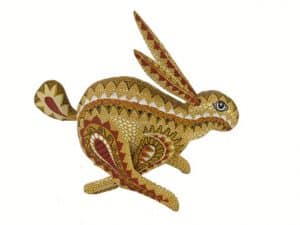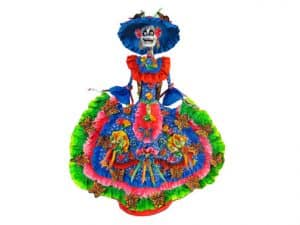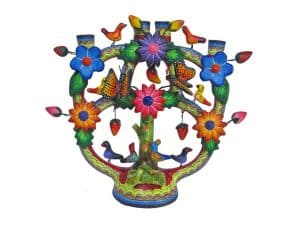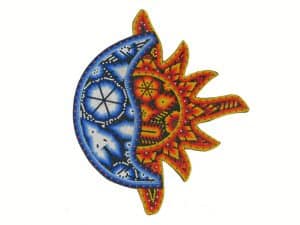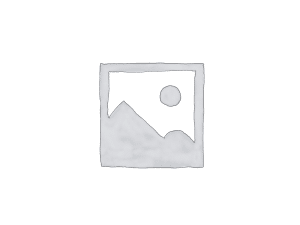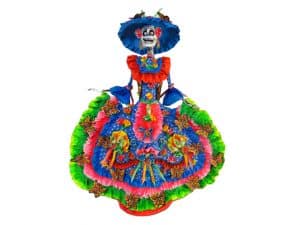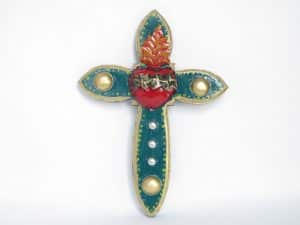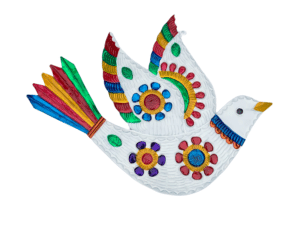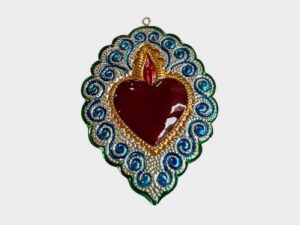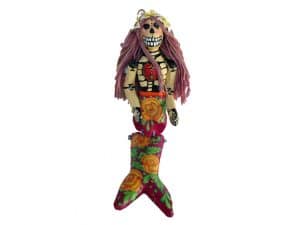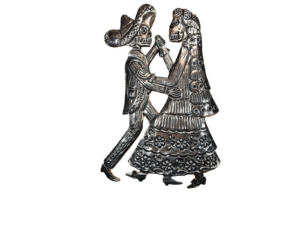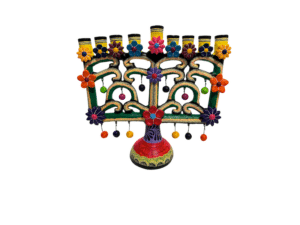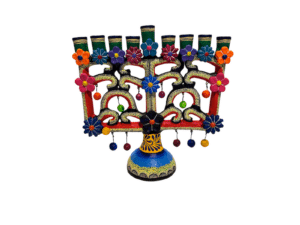We’re showcasing the creative drive and artistic vitality of the renowned artisans who make Mexican Folk Art.
What is Mexican folk art?
The wide range of products for sale here at Viva Oaxaca Folk Art, are handmade by people who have no formal training in their artistry. Often, the artisans are self-taught, mastering their skills and creativity of the course of many years. Others have been taught by elders, passing along the artistry to children, continuing through the generations. Many of the artisans, in fact, have more established lines of employment. They maintain day jobs, such as farming or factory work, but they reserve time to make their crafts on the side. Whether striving to fulfill their artistic drives, or to supplement their income, their artwork is an expression of their traditions, many of which are rooted in the pre-Hispanic cultures and values of the indigenous peoples.
Mexican folk art is produced in a variety of forms, from a multitude of raw materials. Mexico is a country with a wide range of climates and land types ranging from mountainous terrains, to fertile valleys to a diverse and extensive shoreline. As centuries passed, dozens of ethnic communities developed, separated from each other by mountains and canyons. The barriers of topography fostered development of unique languages, cultures and art forms. Folk Art collectors exploring Mexico will find a wide spectrum of quality, and a corresponding range of prices. Within one village, whether populated by families of tinsmiths, pottery makers or wood carvers, will be pieces of appeal to everyone, whether they be unsophisticated collectors or curators seeking works for top art museums. Generally, one person does all the work. From the gathering of the raw materials to the cutting, tooling, embossing, carving or molding, then on to the final burnishing or painting, the artisans of Mexican folk art do it all.
Here at Viva Oaxaca Folk art, we buy the majority of our products in the towns and villages surrounding the cities of Oaxaca (pronounced wah-HAH-ka), Puebla and Guanajuato. Whenever possible, we buy directly from the artisans, avoiding any middlemen, so the compensation goes right to the gifted, hard-working craftsmen who make these wonderful things. Explore our website and discover inspiring Mexican Folk Art products in several categories.
Oaxacan Wood Carvings
These colorful, whimsical wood figures from Oaxaca have become the most sought-after folk art in Mexico. It can be argued that they are not really folk art, since the making of these wood figures is neither centuries’ old nor a creation of indigenous peoples. In the 1980s, a peasant carver named Manuel Jiménez, living in the village of Arrazola, captured the attention of tourists with the appealing figures he was carving. Jimenez quickly found a ready market for his work in the street markets of Oaxaca City. Eventually the appeal of making carvings caught on with his fellow villagers and with farmers and campesinos in other towns — La Union Tejalapam and San Martin Tilcajete. They, too, found that this expression through carved wood figures, of their imagination and creativity could find eager buyers and generate much needed income. Soon, dozens of carvers, some more talented than others, were making these wooden “alebrijes,” as they were called. After Smithsonian Magazine did a cover story on alebrijes in 1987, they became widely seen as traditional Oaxacan folk art creations.
There is an interesting division of labor that I have seen repeatedly among the families making Oaxacan carvings. The gathering, chopping and carving of the wood is done by males, both men and boys. After the initial rough carving, done with machetes and hand-knives, the wood is left to dry, often for several months. Then the carver’s children sand the carving to a smooth finish, a low-skill and rather boring part of the job. It is the women who seem to be doing the most creative and painstaking part, the elaborate painting of the figures. In decades past, the carvings were signed only by the male head of the family. I have noticed a nice trend in recent years that more and more of the carvings bear the names of both the husband and wife.
Among the most popular Oaxacan wood carvings on our website are Arsenio Morales’s big-eared rabbits, with their shiny glass eyes. The Blas family, who live in the mountainous Sierra Norte region of Oaxaca state, create brightly painted, whimsical alebrijes made from copal wood. They specialize in making things like dragons and bats, and captivating, colorful insects. Tribus Mixes, a cooperative of artists from the Mixes tribe, makes figures ranging from 5 inches to 5 feet tall. Probably most spectacular are their peacocks, some fitting nicely on a fireplace mantel while giant ones look majestic set against a wall in a fancy, Mexican restaurant. Their Pegasus horses are similarly sought-after, another creature with wings and flashy feathers.
Decorative Mexican Tin Art
Hand-tooled tin-ware, one of Mexico’s most unique and colorful crafts, has been a popular artist’s medium since Spanish Colonial times. The raw material is produced in factories where workers coat thin sheets of iron with molten tin. This creates a lightweight, durable product with a smooth, shiny finish. It can be easily bent, crimped, cut and soldered to form intricate shapes. Its silver-like gleam and its affordability made it a popular medium in generations past. Mexicans decorated their homes and churches with tinplate picture frames, candelabras, saints’ crown and angels’ wings. It also was used widely for kitchen utensils such as graters and measuring cups, and for making kids toys.
In Mexico today, there are two centers of tinwork – Oaxaca and San Miguel de Allende—and we have products from both. Most popular are Oaxaca’s flat and colorful Christmas ornaments, made in a vast array of designs, from angels to Santas to armadillos to smiling sun faces and pointy, 3D stars. Viva Oaxaca has the net’s biggest collection of handmade tin heart plaques, also from Oaxaca, whose uses range from wedding décor to sacred, flaming heart religious wall plaques. From San Miguel we offer a wide array of tin wall decor frames known as nichos. These hand-painted boxes have a hinged, glass door that opens to a compartment holding a picture of a saint or beloved public figure. Ours have images of the Lady of Guadalupe, of Frida Kahlo, and a variety of Day of the Dead skeleton images.
Day of the Dead Art
Mexico’s Day of the Dead festival is the ultimate homecoming. Generally, the biggest family gathering of the year, the two-day event takes place November 1 and 2. Those are the days when, it is believed, the spirits of the deceased loved ones return back to earth to silently commune with their friends and families. Although the theme is death, the celebration is an uplifting affirmation of respect and love for the dearly departed family members. The holiday is a combination of the ancient Aztec and Toltec beliefs and the Christian feasts of All Saints and All Souls Days. The pre-Hispanic tribes believed that death was not something to be feared or mourned; rather it was a natural phase within life’s long journey. The centerpiece of a family’s Day of the Dead celebration is the altar, set-up either within the home or at the cemetery. The altar is laden with offerings – food, drink, family photos, children’s toys, whimsical skeleton figures – to help welcome the spirits back to earth after their long journey home.
The most ubiquitous symbol, and among the most sought-after items of Day of the Dead folk art, is the skeleton lady in fancy dress and a wide-brimmed, Victorian hat. Named Catrina, her message is “Todos somos Calaveras,” meaning, roughly, underneath all our clothing, whether fancy dress or beggar’s rags, we are all skeletons and thus, all alike. And ultimately, heading to the same place. Also popular are brightly decorated skulls, whether made from pottery, wood, Huichol beads, papier mâché, chocolate or sugar. Colorful papel picados, draped over altars or strung across ceilings in restaurants are sheets of fragile tissue paper, with images of skeleton figures cut out of them. The artist painstakingly creates the image using hammer and chisel cutting designs into multiple layers of paper. It is a great example of Mexican ephemeral art, something that takes much time and care to create, but is not meant to be enjoyed for more than a day or two.
Mexican Polychrome Pottery
Earthenware pottery is the most common type of Mexican folk art. The clay is sticky dirt dug out of the ground that holds its shape when molded. When heated to high temperatures it partially melts becoming a hard, rock-like substance. First made in North America around 4500 years ago, the artistic output today is a melding of Indian shapes, colors and patterns with Spanish techniques of glazing and firing. We feature glazed pottery (Barro Policromado) from Izucar de Matamoros, especially the renowned designs of the Castillo family. These take the form of Trees of Life candelabras, often with a religious Adam and Eve theme, pottery sculptures of religious figures such as the Lady of Guadalupe and various fired then hand-painted figures such as owl candlesticks, and clever skeleton motifs.
Huichol Indian Beaded Art
Huichol Indians are perhaps the most storied indigenous peoples living in Mexico today. Their homeland is located in remote parts of the Sierra Madre mountains in the states of Jalisco and Nayarit. Descendants of the Aztecs, they still maintain their pre-Columbian traditions and language, and live in rugged, mountain communities without electricity and running water. There are said to be only about 18,000 Huichol people today, living mostly in settlements where houses have dirt floors and grass-thatched roofs.
The Huichols, or Wixárika as they prefer to be called, cling strongly to their ancient indigenous beliefs. Their lives revolve around elaborate religious traditions which have remained unchanged since hundreds of years before the Spanish conquest. The Huichols believe that their ancestors, the “first people,” were deities who lived in the Wirikuta desert but were later driven out into the mountains to live as mortal farmers. They revere the deer, which is an integral part of their spiritual ceremonies.
The Huichol people are known for their beautiful artwork which is created for display in their temples and religious caves. Beaded eggs, jaguar heads and ceremonial bowls with colorful patterns are considered sacred, bearing designs and color patterns derived from their spirituality. These things are made by coating the bottom of a gourd, or the wooden figure of an animal with a mixture of beeswax and pine tar. Then, one-by-one, the artist presses into place hundreds of brightly-colored glass beads. The creation of these works of art require a great deal of inspiration, patience and concentration, all characteristics of the Huichol outlook on life. Intricate yarn paintings, made with a similar technique of pressing colorful bits of yarn onto wax-coated plywood disks, are another form of their unique, artistic expression. Each painting tells a story from Huichol mythology, and is one-of-a-kind.



